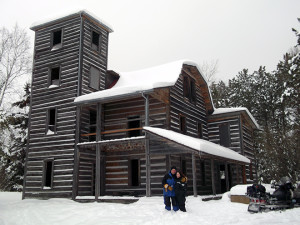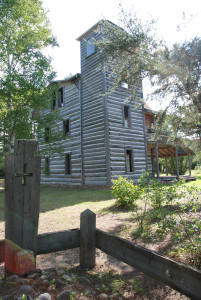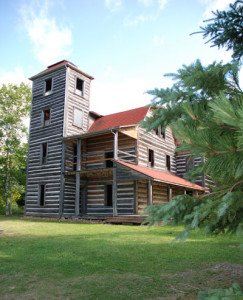White Otter Castle – NW Ontario – Ignace/Atikokan
The White Otter Castle of Northern Ontario – Love Story and
Dedication to Heritage Preservation
by Back Roads Bill
Within the why and how of non-fiction there is a story. And in the story there is usually a person who makes a real difference.
A memorable story with feelings and emotions can only be told by a person who is intimate with the details. This person has to live and value heritage at a scale that inspires action and dedication, beyond the scope of a job.

White Otter Winter
The White Otter Castle is a story that could have only happened in the wilderness of Northern Ontario. And it is a cabin like no other. The storyline speaks of romance and tragedy. Shakespeare would have used the craggy environment of Scotland. It has the classic man versus nature theme. As a structure it has endured more than century. It represents the building of a dream inspired by an intended love and perhaps a love not forgotten.
Dennis Smyk writes in a commemorative booklet entitled ‘White Ottler Castle – Historical and current photos, stories, letters and poems about the Castle and its builder, Jimmy McQuat – celebrating the 150th Anniversary of his birth.’ He told ‘Community Voices,’ “At the turn of the century (19th) White Otter Lake was very isolated, accessible only by canoe in summer and over the ice in winter. Yet, beginning with a writer named Hodson who canoed to the Castle in 1914 and wrote about his visit in “Rod and Gun” (magazine), thousands ofpeople have the Castle as a destination by canoe, motorboat, snowmobile and aircraft trips to the White Otter area.”
What do you see?
This castle is a log building, 28’ X 38’ and three storeys high, with a four storey tower and a two storey kitchen. It was built of red pine logs varying in diameter from 10-18,’ with some as large as 24.” The 26 windows were transported, ready-made, from Ignace by canoe over 15 portages, a distance of about 20 miles. While it may not seem significant in itself, the attractiveness and uniqueness of White Otter Castle is that it was built by one man!

Grave site
Jimmy McQuat was born in the Ottawa Valley in 1855. He homesteaded on the Rainy River in 1887. He gambled and lost everything the areas’ gold rush and arrived on White Otter Lake in 1903, building a shack near the cabin site. It is not sure when he started the construction of the Castle but by 1914 he was living in it. Why he built it is still a mystery. He offered it as a convalescent home for World War I soldiers; he built it because of a curse that said he’d die in a shack (he told Hodson, “Ye couldn’t call this a shack, could ye?”); he built it for a bride who never came…”
There was a real bride to be. A neighbouring homesteader of McQuat’s returned east for his own family. He took with him a letter of introduction regarding Jimmy’s intentions to marry and make a life. A young nineteen year old, Jane Gibson, agreed to the match through correspondence in the late 1880’s. She would be, in essence a mail order bride. She had sent Jimmy a photograph and eventually requested Jimmy to journey to Clifford, Ontario to meet her family, a condition of matrimony. He declined and she married another man. It was the start of a myth of lost love. Jimmy McQuat embarked on a building a log cabin like no other.
The body of Jimmy McQuat was found on June 27th, 1919, he had been missing since the previous fall while out netting fish. Fire rangers found his body washed up on his own beach and buried him in front of the Castle, his legacy.
Making a Difference
Dennis is the editor and owner of the local newspaper the ‘Driftwood’ and is a leader in the community of Ignace He along with community members spent many hours and years moving the restoration project forward. The castle and its story are there today because of their efforts.
Dennis was an inaugural member of the ‘The Friends of White Otter Castle Committee appointed by municipal council in November of 1984. The Committee initially evaluated the eroding log castle. (Some previous restoration work was undertaken at the castle in the mid 1950’s prompted by a visit by then Premier Leslie Frost.) As time has its way the Castle continued to deteriorate. The trials and tribulations of a determined community took another eight years. It included government funding proposals and community fund raising. You can only imagine a million dollar restoration of a log cabin in the wilderness with tax payers’ dollars created a climate of skepticism and delay. Perseverance prevailed.
It was proposed the Castle be dismantled for testing of the logs. In fact the Castle was lifted so a log at a time could be tested for needed replacement. New logs were transported over the ice in 1991. Construction of the estimated $1.5 million capital project began in the summer of 1992 with completion in 1994. The 1919 exterior finish was preserved.
In February of 2013 Dennis was presented with the province’s prestigious Queen’s Diamond Jubilee Medal for his long career of community service and his ongoing efforts to preserve the castle.
Access and Graffiti
White Otter Lake is not so difficult to access. You first must visit Atikokan off of Highway 11 and west of Thunder Bay or Ignace, to the north on Highway 17.

Summer
Bringing canoes, kayaks or your own boat is a challenge; the easiest way is to rent a small boat and motor at the bottom end of Clearwater West Lake at Browns’ Clearwater West Lodge. Drive north form Atikokan on Highway #622. There is a campground at the Lodge. There is also a nearby Crown Land access point. From these two access points you could canoe or kayak northwards to White Otter Lake. The lodge shuttles you over the portage on a trailer from Clearwater West Lake to White Otter Lake. At the north end of Clearwater West Lake, the small boat is floated on to a trailer. You stay in the boat and are towed over the short portage and are refloated. It seems surreal to think about this transfer, but it is quick and efficient. You are on your way to discover White Otter Castle (WGS 84 N49° 10.259’ W91° 54.574’ and 15 U E579483 N5447035).
Another access is the Turtle River Provincial Park canoe route (east part). There is access from Agmimak Lake in Ignace. Or closer still to White Otter Lake at Moosehide Lake via the Moosehide Road (22 km west of Ignace, 26 km south and then 4.5 km east to Moosehide Lake). Travelling southwards, you will be within four short portages (less than 10 km) of White Otter Lake (entering McQuat Bay, the northeast bay of White Otter Lake).
Along the same shoreline moving north from the Castle, move to the next small bay. This is the location of a former WW I Prisoner Of War encampment, for German prisoners. Later the location was also used as a logging camp. You will find a foundation and metal debris in the backshore. There are many pictograph sites on the lake.
When we consider the issue of graffiti, is it art or crime? On the interior of the Castle there are hundreds of signatures etched and written on the log walls. It is an interesting behavioural study. Because if it is a crime, there have been a good many criminals here. The opportunity to leave some graffiti at this isolated location almost seems like the completion of a pilgrimage to the many that make the Castle a destination. Is it respectful to leave a message at such a place? Words from the inner spirit and self are chosen to reflect the intimacy of this place. Perhaps because of the destination the messages are not garish but complimentary. We did. It was almost magnetic. With daughter Ali – it is on the west corner of the third floor stairs going up – two steps to the platform on the horizontal beam meeting the vertical corner post; look up before turning left to go up the steep stairs. See if you can find it. Leave your tasteful mark and take away the memories.
When you visit the castle come to appreciate the life of Jimmy McQuat and appreciate the dedication and commitment of Dennis Smyk. It is why we have characters that become part of both legends and truths.
Google Maps